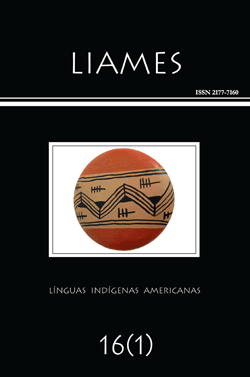Resumo
The ethnonym Antipa was commonly mentioned as one of the major lowland Jivaroan (also known as Chicham) tribes of north Peru in the late 19th and early 20th centuries, before disappearing both from the historical record and from the oral history of the modern Jivaroan groups. This work presents insights gained by approaching the sparse historical data from a linguistic perspective. Taking into account documented linguistic evidence, the possible etymology of the ethnonym, and evidence from oral tradition, it suggests tentative hypotheses regarding the origin and disappearance of the Antipa ethnonym.
Referências
ADELAAR, Willem F. H. (with P. Muysken) (2004). The languages of the Andes. Cambridge: Cambridge University Press.
BEUCHAT, Henri; Rivet, Paul (1909). La langue Jíbaro ou Šiwora. Anthropos 4: 805–22.
CAMPBELL, Lyle (2012). Classification of the indigenous languages of South America. In Lyle Campbell; Verónica Grondona (eds.). The indigenous languages of South America, pp. 59–166. Berlin: Mouton de Gruyter.
CHANTRE Y HERRERA, José (1901). Historia de las misiones de la Compañia de Jesús en el Marañón español por el P. José Chantre y Herrera. Madrid: Imprenta de A. Avrial.
COLINI, Giuseppe Angelo (1883). Osservazioni etnografiche sui Givari. In Atti della R. Accademia dei Lincei (3rd series) 11: 337–80.
CUESTAS, José (1961). Los Huámbucos, una tribu indígena del río Chinchipe desaparecida. Perú indígena: Órgano del Instituto Indigenista Peruano 9(20/21): 67–72.
FLECK, David W. (2007). Did the Kulinas become the Marubos? A linguistic and ethnohistorical investigation. Tipití: Journal of the Society for the Anthropology of Lowland South America 5(2), article 2, pp. 137-207. Available at: http://digitalcommons.trinity.edu/tipiti/vol5/iss2/2
GNERRE, Maurizio (1973). Sources of Spanish Jívaro. Romance Philology 27(2): 203–4.
GNERRE, Maurizio (1975). L’utilizzazione delle fonti documentarie dei secoli XVI e XVII per la storia linguistica jíbaro. In E. Cerulli; G. Della Ragione (eds.). Atti del XL Congresso Internazionale degli americanisti, vol. 3, pp. 79–86. Genoa: Tilgher.
GONZÁLEZ HOLGUÍN, Diego (1608 [2007]). Vocabvlario de la lengva general de todo el Perv llamada lengua Qquichua, o del Inca. Digital edition published by Runasimipi Qespisqa Software.
GUALLART, José María (1990). Entre pongo y cordillera: Historia de la etnia aguaruna – huambisa. Lima: Centro Amazónico de Antropología y Aplicación Práctica.
HAMY, Théodore Ernest (1873). Nouveaux renseignements sur les indiens Jivaros. Revue d’Anthropologie 2: 385–397.
VON HASSEL, Jorge M. (1905). Las tribus salvajes de la región Amazónica del Perú. Boletín de la Sociedad Geográfica de Lima 17: 27–73.
JIMPIKIT, Carmelina; Antun’, Gladys (2000). Los nombres Shuar: Significado y conservación. 2nd edition. Quito: Abya-Yala.
LOUKOTKA, Čestmir. 1968. Classification of South American Indian Languages. Los Angeles: University of California.
VON MURR, Cristoph Gottlieb (1785). Reisen einiger Missionarien der Gesellschaft Jesu in Amerika. Nurnberg: Johann Eberhard Zeh.
OVERALL, Simon E. (2008). On the non-phonemic status of the velar nasal [ŋ] in Jivaroan. LIAMES - Línguas Indígenas Americanas 8: 45–59.
PRIETO, A. J. 1885. Descripción de la provincia de los jívaros, su religión, costumbres y producciones. In Francisco María Compte (ed.). Varones ilustres de la Orden Serafica en el Ecuador, desde la fundación de Quito hasta nuestros días (2nd ed., vol. 2), pp. 63–68. Quito: Imprenta del Clero.
RAIMONDY, Antonio (trans. W. Bollaert) (1863). On the Indian tribes of the Great District of Loreto, in Northern Peru. Anthropological Review 1(1): 33–43.
RIVET, Paul (1907). Les indiens Jíbaro. Étude géographique, historique et ethnographique. L’Anthropologie 18: 333–368; 583–618.
RODRÍGUEZ, Manuel (1684). El Marañón y Amazonas: Historia de los descubrimientos, entradas, y reducción de naciones. Madrid: Imprenta de Antonio Gonçalez de Reyes.
SIVERTS, Henning (1975). Jívaro head hunters in a headless time. In Martin A. Nettleship R. Dalegivens Anderson Nettleship (eds.). War, its causes and correlates, pp. 663–674. The Hague/Paris: Mouton.
STIRLING, Matthew Williams (1938). Historical and ethnographical material on the Jivaro Indians (Smithsonian Institution Bureau of American Ethnology Bulletin 117). Washington, D.C.: U.S. Government Printing Office.
SURRALLÉS, Alexandre (2007). Los Candoshi. In Fernando Santos; Frederica Barclay (eds.). Guía etnográfica de la Alta Amazonía, vol. 6: 243–380. Lima: Smithsonian Tropical Research Institute/Instituto Francés de Estudios Andinos.
TAYLOR, Anne-Christine (1988). Al Este de los Andes: Tomo II. Lima/Quito: IFEA/Abya-Yala.
UP DE GRAFF, Fritz W. (1923). Head hunters of the Amazon: Seven years of exploration and adventure. New York: Garden City Publishing.
UWARAI YAGKUG, Abel; Paz Suikai, Isaac; Regan, Jaime (1998). Diccionario Aguaruna – Castellano: Awajún Chícham Apáchnaujai. Lima: Centro Amazónico de Antropología y Aplicación Práctica.
VILLAVICENCIO, Manuel (1858). Geografía de la República del Ecuador. New York: Robert Craighead.
WALLIS, Ethel Emily (1965). Tariri: My story from jungle killer to Christian missionary New York: Harper & Row.
WISE, Mary Ruth (1999). Small language families and isolates in Peru. In R. M. W. Dixon and Alexandra Y. Aikhenvald (eds.). The Amazonian Languages, pp. 307–340. Cambridge: Cambridge University Press.
A LIAMES: Línguas Indígenas Americanas utiliza a licença do Creative Commons (CC), preservando assim, a integridade dos artigos em ambiente de acesso aberto.
Os artigos e demais trabalhos publicados na LIAMES: Línguas Indígenas Americanas, publicação de acesso aberto, passa a seguir os princípios da licença do Creative Commons. Uma nova publicação do mesmo texto, de iniciativa de seu autor ou de terceiros, fica sujeita à expressa menção da precedência de sua publicação neste periódico, citando-se a edição e a data desta publicação.

